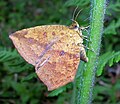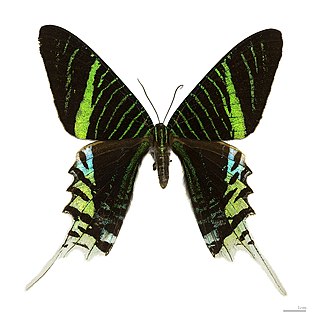Morphological differences

Shape and structure of antennae
The most obvious difference is in the feelers, or antennae. Most butterflies have thin slender filamentous antennae which are club shaped at the end. Moths, on the other hand, often have comb-like or feathery antennae, or filamentous and unclubbed. [2] [3] This distinction is the basis for the earliest taxonomic divisions in the Lepidoptera: the Rhopalocera ("clubbed horn", the butterflies) and the Heterocera ("varied horn", the moths).
There are, however, exceptions to this rule and a few moths (the families Castniidae, Uraniidae, Apoprogonidae, and Sematuridae [4] ) have clubbed antennae. Some butterflies, like Pseudopontia paradoxa from the forests of central Africa, lack the club ends. The hesperiids often have an angle to the tip of the antenna.
Wing-coupling mechanisms
Many moths have a frenulum which is a filament arising from the hindwing and coupling (matching up) with barbs on the forewing. The frenulum can be observed only when a specimen is in hand. There is only one known species of butterfly with a frenulum, which is the male regent skipper Euschemon rafflesia . [5] Some moths have a lobe on the forewing called a jugum that helps in coupling with the hindwing. Butterflies lack these structures.
Pupae
Most moth caterpillars spin a cocoon made of silk within which they metamorphose into the pupal stage. Most butterfly caterpillars, on the other hand, form an exposed pupa made from a hardened protein, also termed a chrysalis.
- Moths typically form a cocoon
- Butterflies typically form a chrysalis
There are many exceptions to this rule, however. For example, the hawk moths form an exposed pupa which is underground. Spongy moths sometimes form butterfly-style pupae, hanging on twigs or tree bark, although usually they create flimsy cocoons out of silk webbing and leaf bits, leaving the pupa exposed. The plume winged moths of the family Pterophoridae also pupates without a cocoon and the pupa resembles the chrysalis of the pierid butterfly. A few skipper butterfly larvae also make crude cocoons in which they pupate, exposing the pupa a bit. The Parnassius butterfly larvae make a flimsy cocoon for pupation and they pupate near the ground surface between debris.

Colouration of the wings
Most butterflies have bright colours on their wings. Nocturnal moths on the other hand are usually plain brown, grey, white or black and often with obscuring patterns of zigzags or swirls which help camouflage them from predators as they rest during the day. However, many day-flying moths are brightly coloured, particularly if they are toxic. These diurnal species evolved to locate their mates visually and not primarily by pheromone as their drab nocturnal cousins. [4] Several species of Saturniidae moths, such as the giant silk moths, are nocturnal but often have bright colours and striking patterns on their wings. A few butterflies are also plain-coloured, like the cabbage white butterfly or the baron butterfly.
Structure of the body
Moths tend to have stout and hairy or furry-looking bodies, while butterflies have slender and smoother abdomens. Moths have larger scales on their wings which makes them look more dense and fluffy. Butterflies on the other hand possess fine scales. This difference is possibly due to the need for moths to conserve heat during the cooler nights, or to confound echolocation by bats, whereas butterflies are able to absorb sunlight.
Eye types
Despite appearances, butterflies and moths have different types of compound eyes. Though not universal, moths very commonly have superposition eyes, while butterflies equally commonly favour apposition eyes. This is due to the superposition eye's adaptations for low light environments suiting the nocturnal moths, and the apposition eye's superior resolution and potential for colour vision benefiting the more diurnal butterflies. [6]
There are several exceptions to this rule, such as with the diurnal Zygaenidae and Sytomidae families of moths, both of which have apposition eyes, or the Hedyloidea family of butterflies, which are nocturnal and feature superposition eyes. [7] In most cases where one species is found to be using the opposite type of eye than expected, it is because they are active during the opposite time of day than is normal for other butterflies or moths.



























